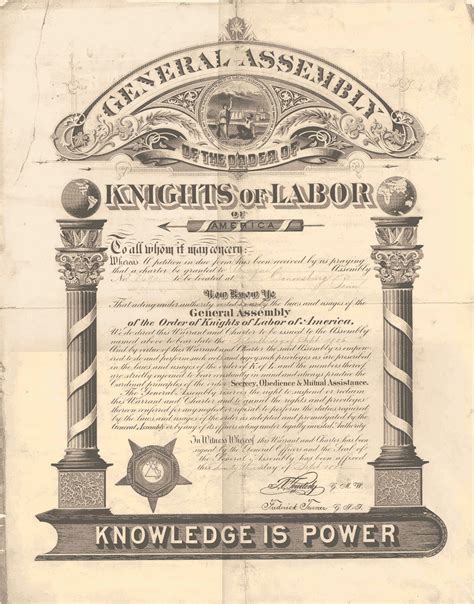Understanding the Knights of Labor
The Knights of Labor, founded in 1869, emerged as a prominent labor organization in the United States during the late 19th century. This fraternal organization sought to unite workers from all walks of life, regardless of skill or occupation. Here are key statements that accurately describe the Knights of Labor’s principles and objectives:

Principles and Objectives of the Knights of Labor
-
Strove to abolish the wage system and establish cooperative enterprises owned and controlled by workers. The Knights believed that the existing capitalist system exploited workers and created unjust wealth disparities. They advocated for a system where workers could directly benefit from their labor.
-
Promoted an inclusive membership policy that welcomed workers of different skills, trades, and backgrounds. Unlike earlier labor organizations that often focused on skilled workers, the Knights sought to unite all working people, including women, African Americans, and immigrants.
-
Utilized a variety of tactics to advance their goals, including strikes, boycotts, and political agitation. The Knights organized large-scale strikes and boycotts to pressure employers to meet their demands. They also engaged in political activism, advocating for legislation that supported workers’ rights.
-
Emphasized education and worker solidarity. The Knights established educational programs for its members, believing that knowledge was crucial for their empowerment. They also fostered a sense of unity among workers, promoting the idea that they shared common interests and goals.
Distinctive Features of the Knights of Labor
-
Broad-based membership: The Knights of Labor was one of the first labor organizations in the United States to actively recruit workers from all occupations and backgrounds. It represented a wide range of industries, including manufacturing, mining, transportation, and agriculture.
-
Emphasis on unity: The Knights recognized the power of unity and sought to create a cohesive labor movement. They believed that by uniting workers across different sectors and regions, they could increase their collective bargaining power and achieve their goals more effectively.
-
Political engagement: While the Knights focused primarily on economic reforms, they also recognized the importance of political action. They established a political arm known as the National Labor Reform Party and supported candidates who aligned with their platform.
Impact and Legacy of the Knights of Labor
The Knights of Labor played a significant role in the American labor movement. At its peak, the organization had over 700,000 members and organized several notable strikes and boycotts. Although the Knights faced setbacks and eventually declined in influence, their legacy continues to inspire labor activists and scholars today.
Frequently Asked Questions
Q1: What were the primary goals of the Knights of Labor?
A: To abolish the wage system, establish worker-owned cooperatives, and promote worker solidarity.
Q2: What made the Knights of Labor unique compared to other labor organizations of the time?
A: Its broad-based membership policy, emphasis on education, and active engagement in political action.
Q3: What were some of the tactics used by the Knights of Labor?
A: Strikes, boycotts, and political agitation.
Q4: What factors contributed to the decline of the Knights of Labor?
A: Internal divisions, government repression, and the rise of more radical labor organizations.
Tables
Table 1: Membership of the Knights of Labor
| Year | Number of Members |
|---|---|
| 1886 | 702,593 |
| 1890 | 200,000 |
| 1895 | 100,000 |
Table 2: Major Strikes Led by the Knights of Labor
| Year | Strike | Industry |
|---|---|---|
| 1877 | Great Railroad Strike | Transportation |
| 1882 | Baltimore & Ohio Railroad Strike | Transportation |
| 1885 | Haymarket Square Riot | Manufacturing |
Table 3: Political Candidates Supported by the National Labor Reform Party
| Year | Candidate | Office |
|---|---|---|
| 1884 | Benjamin Butler | President |
| 1888 | Alson Streeter | President |
| 1892 | James Weaver | President |
Table 4: Key Figures in the Knights of Labor
| Name | Role |
|---|---|
| Uriah Stephens | Founder |
| Terence Powderly | Grand Master Workman |
| Leonora Barry | Leading Female Activist |
| John Swinton | Labor Advocate and Organizer |
